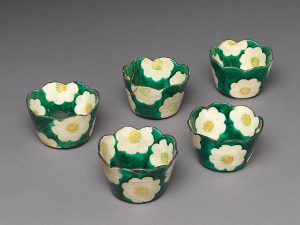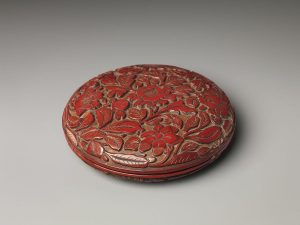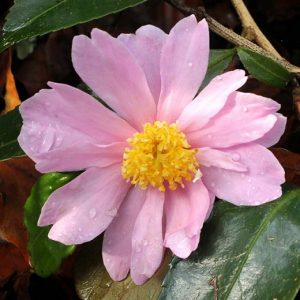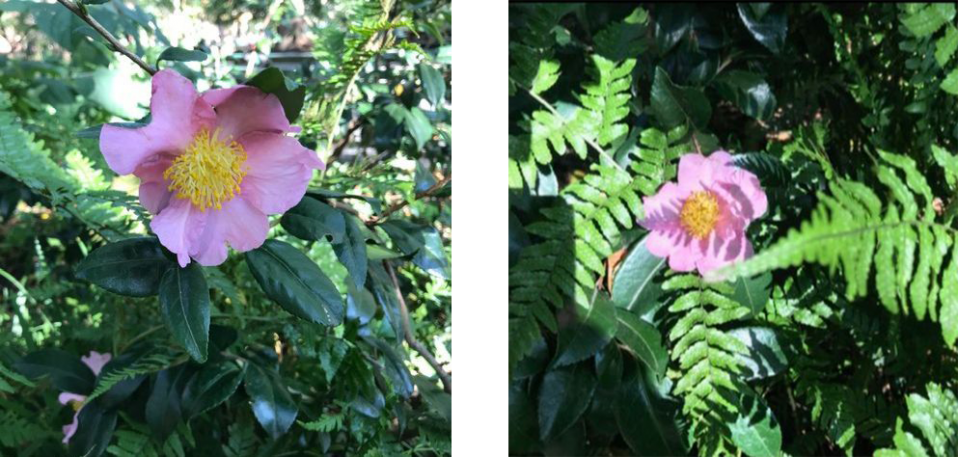Camellias are a genus of flowering plants in the family Theaceae, also known as the “tea family.” The evergreen shrubs or large trees can grow up to 66 feet tall. Their flowers range in size, shape, and color, coming in whites, pinks, and reds with single or double rows of petals. Depending on the variety, camellias grow during the fall, winter, and/or spring. They flourish in colder temperatures in the shade and can withstand large volumes of water. The camellias in our park (pictured above) are called “Winter’s Rose.” They are a smaller, very hardy variety, and they bloom for four to six weeks in the fall.
The composition of camellias and their color are all thought to represent different aspects of love. The petals of the flower symbolize a person, while the calyx (green part that holds everything together) is thought to represent their partner. Unlike other flowers, the calyx of the camellia falls with the petals, symbolizing unity and undying love between lovers. Red camellias are associated with passion and desire, while white camellias are generally associated with innocent love. Pink camellias are associated with the desire to be with a loved one, and relate to long distance relationships and love that is just out of reach.

Sparrow and Snow-covered Camellia, ca. 1845, Japan The Met JP2535
Camellias and their meanings originate in East and South Asia. The first fossils of camellias were found in Japan and date to the Eocene Epoch, which occurred roughly 56 to 33 million years ago. They are called tsubaki in Japanese, cháhuā (tea flower) in Chinese, and dongbaek-kkot in Korean. Camellias appear as motifs throughout the regions’ histories, in paintings, on ceramics, textiles, and other objects (see at right and below). They are still traditionally used in celebrations of Chinese New Year and Korean wedding ceremonies because of their associations with love and good fortune. The plant can be processed into oil used for cooking and cosmetics, and is used in traditional Chinese medicine to treat various diseases, such as asthma and bacterial infections. Most popularly, the leaves of a particular species of white camellia are used to make tea, which spurred its popularity outside of Asia.
Before 1739, when the first live camellia arrived in Europe, people outside of Asia only knew of camellias through artistic depictions and verbal descriptions. For example, the English name camellia is derived from Jesuit botanist and missionary Georg Joseph Kamel, who worked in the Philippines and described a species of camellia. With the expansion of the tea trade in the 18th century, more varieties of camellias were increasingly imported by the British East India Company and began appearing in greenhouses and in beverages on the kitchen table.
As trade in camellias increased, the flower eventually reached the United States in 1797, when industrial pioneer Colonel John Stevens brought the flower as part of an effort to grow attractions within Elysian Fields in Hoboken, New Jersey. By 1807, the plant was widely found in greenhouses, and then was taken outdoors and planted in the American South. By 1959, it was named the state flower of Alabama, and it can still be found across the States. In fact, Alabama, California, Florida, Louisiana, Mississippi, Oregon, and Georgia each have a “Camellia City,” because of the wide presence of the plant.

Set of Five Camellia-Shaped Side Dishes with Camellia Patterns, 18th century, Japan The Met 2019.193.56a–e

Box with Camellias, 13th century, China The Met 2005.140a, b
The spread of camellias has caused them to hold significant cultural significance outside of Asia. White camellias became a symbol of the women’s suffrage movement in New Zealand and appear on the country’s ten-dollar note. Camellias represent a courtesan’s sexual availability in Alexandre Dumas’s The Lady of the Camellias, the protagonist of which inspired Coco Chanel to use a white camellia as the symbol of Chanel haute couture. The Knights of the White Camellia was an American terrorist organization with ties to the Ku Klux Klan that supported white supremacy and slavery in the 19th century. In contrast, the camellia was also a symbol of Brazil’s abolitionist movement, and it was common practice for abolitionists to plant camellias in a show of solidarity.
 Because of their association with longing, the pink “Winter’s Rose” camellias in our park (at right) can be thought to poetically symbolize the distances we have created while in quarantine. We may long for our friends, family, and the nostalgia of pre-pandemic times. Yet, there is also a delicate beauty in our longing that will make the experience of finally being reunited so much sweeter.
Because of their association with longing, the pink “Winter’s Rose” camellias in our park (at right) can be thought to poetically symbolize the distances we have created while in quarantine. We may long for our friends, family, and the nostalgia of pre-pandemic times. Yet, there is also a delicate beauty in our longing that will make the experience of finally being reunited so much sweeter.


